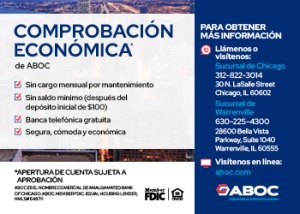Latest
-
 Lincoln Park Zoo Celebrates Earth Week April 24, 2025
Lincoln Park Zoo Celebrates Earth Week April 24, 2025 -

-
 EXPO Chicago Returns to Navy Pier April 24, 2025
EXPO Chicago Returns to Navy Pier April 24, 2025 -

-
 Advocates Defending Social Security for Immigrants April 24, 2025
Advocates Defending Social Security for Immigrants April 24, 2025
Popular
Tags
Artistas Adolescentes Aprenden el Valor de un Arduo Trabajo
Artists Nationwide
Brazilian Students Tour Kirie Water Reclamation Plant
Challenges of Returning to School in Adulthood
Chicago
Chicago Air and Water Show
Chicago CPS
Chicago Dream Act
Comparta su Historia
CPS
Cultura Latina
Delicious Salad Meals
Dream Act
Dream Act chicago
Dream Relief
Dream Relief Chicago
El Alma de la Fiesta
Ending Summer on the Right Foot
Ensaladas sencillas y deliciosas como plato principal
Estudiantes Brasileños Recorren la Planta de Reclamación de Agua Kirie
Feria de Regreso a la Escuela de la Rep. Berrios
Festival Unísono en Pilsen
Grant Park Spirit of Music Garden
ICIRR
ICIRR Receives Criticism Over Dream Relief Day
ICIRR Recibe Críticas
Jose Cuervo Tradicional
José Cuervo
José Cuervo Tradicional Celebra la Cultura Latina e Inspira Artistas a Nivel Nacional
Latin Culture
Los Retos de Volver a la Escuela Cuando Adultos
Meijer Abre sus Puertas en el Distrito de Berwyn
Meijer Opens in Berwyn District
orth side Summer Fest on Lincoln Ave
PepsiCo Foundation Apoya Futuros Periodistas Hispanos
PepsiCo Foundation Supports Future Hispanic Journalists
Share Your Story
Show Acuático y Aéreo
Simple
StoryCorps
storycorps.org
Teen Artists Learn the Value of Hard Work
Terminando el Verano con el Pie Derecho
Unisono Festival in Pilsen
‘El Chente’




The Mystery of the Cocoliztli Plague Solved?
By: Daniel Nardini
We know what it was from the Spanish chronicles of the time; in 1545 a devastating plague struck the Aztec people (or those who had survived the Spanish conquest) and in only five years had killed off 80 percent of the entire Aztec people. The symptoms were a high fever, headaches, and bleeding from the eyes, nose and mouth. Within three to four days those afflicted were dead. At first, historians thought it might be smallpox. However, the mysterious illness did not cause black spots and open sores characteristic of smallpox. Was it the measles or malaria? The answer seems to also be negative. So what could this plague have been? The Nahua people, the descendants of the Aztecs, called this the “cocoliztli,” which means “pestilence.” It certainly was a pestilence—it was one of the worst epidemics in human history. It almost came to equal the Black Death that killed 25 million people in Europe in the 13th Century A.D.
The Spanish priests of the time, who were helpless to stop the widespread death of the Aztec populace, had to bury the dead quickly in deep pits to make sure that the plague did not spread any further. From one of these pits a group of researchers from the University of Tuebingen in Germany have examined the DNA of the skeletal remains of the victims of the cocoliztli. What they discovered is that the one contagion, known as salmonella enterica bacterium, was common in all of the victims. The researchers theorize that the introduction of cattle and other beasts of burden brought from Europe may have started a major outbreak of salmonella in the Aztec population. Since the Aztecs had never encountered anything like this before (that, and the Europeans were already immune to this virus), they easily fell victim to this previously unknown contaminant. Could it have been prevented? The Spanish knew nothing about viruses, about disease prevention, and they certainly did not know how to stop a full-blown plague beyond trying to bury the dead as fast as possible or maybe douse them with quick lime. Even these measures did not work, and eventually the plague burned itself out, but not without devastating consequences. The only good news is that science has prevented for the most part similar plagues from breaking out that could wipe out whole populations in our world.